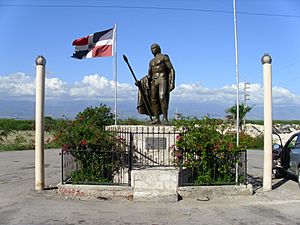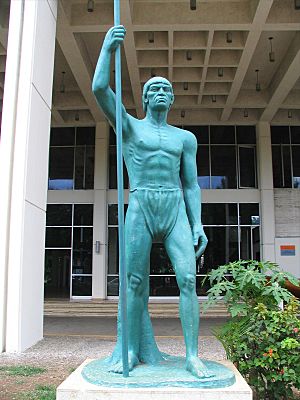Enriquillo facts for kids
Enriquillo, also known as "Enrique" by the Spaniards, was a brave Taíno leader. He led a rebellion against the Spaniards from 1519 to 1533. This rebellion is the most famous one from the early Caribbean period. Enriquillo was born near Lake Enriquillo and came from the royal family of Jaragua. His aunt, Anacaona, was the Queen of Jaragua. Today, Enriquillo is seen as a hero in the Dominican Republic and Haiti. He fought for the rights of his people.
Contents
Enriquillo's Early Life
Enriquillo was born around 1500 into the Jaragua family. He was part of the Taíno people. The Taíno had their own advanced government, cultural traditions, and ways of farming.
Good relations between Christopher Columbus and the Taíno people on the island of Hispaniola did not last long. The Taíno were forced to work very hard in gold mines. They were poorly housed, badly fed, and overworked. They also had to live very close to the Spaniards. This disrupted their food production, causing many to become sick. They were also vulnerable to new diseases brought by the foreigners. After Columbus searched for gold, he turned to slavery and sugar cane plantations to make money.
A Difficult Childhood
Enriquillo's father, his aunt Anacaona, and eighty other Taíno chiefs were killed by Nicolás de Ovando. This happened during what were supposed to be "peace talks" with the Spanish in Jaragua. Spanish soldiers attacked the chiefs, set the meeting house on fire, and killed anyone who tried to escape.
Enriquillo became an orphan. He was later raised in a Santo Domingo monastery and given the name "Enrico." One of his teachers was Bartolomé de las Casas. De las Casas was a Spanish priest who cared about the rights of Native Americans. Enriquillo learned to read and write. He knew his rights as a subject of the colony. Other indigenous people still saw him as a chief, or nitaíno. Because of this, he worked as a foreman for a Spanish landowner.
Enriquillo also had a wife named Mencía. She was later given the noble title Doña because of Enriquillo's high standing. Mencía was treated very unfairly by a Spaniard named Valenzuela. When Enriquillo tried to get justice in the Spanish courts, nothing was done. It was Mencía's word against the Spaniard's. Some writers say this unfairness was the main reason Enriquillo decided to rebel in the Bahoruco mountains.
The Bahoruco Rebellion
Many revolts happened in the early 1500s. The most famous one began in 1519. Enriquillo was one of the few remaining Taíno chiefs. He started the revolt with many Taíno people from the mountain range of Bahoruco. The Taíno were able to keep fighting because they knew the region much better than the Spaniards.
The Spaniards could not stop the rebellion. So, a treaty was signed that gave the Native population rights like freedom and possession. However, this treaty had little effect. By this time, the Native population was quickly dying out due to European diseases.
A Clever Leader
Enriquillo's rebellion lasted thirteen years and cost the Spanish monarchy a lot of gold. There were attacks, fires, raids, and deaths of Spaniards. The rebellion also set a dangerous example for the thousands of enslaved people on the island.
Enriquillo's fighting style made him feared by the Spaniards. He used clever, irregular warfare. He was patient and careful. He also set up a good system for getting information and supplies in the high mountains. He was a true military leader, able to face and defeat the most powerful nation at that time.
His strong resistance forced the King of Spain to send Francisco de Barrionuevo. Barrionuevo's job was to end the long conflict, either by talking or by force.
The Treaty and His Legacy
Enrique del Bahoruco, as he was first known, met Barrionuevo on Cabritos Island. He received a letter from King Carlos. The agreements they made were never fully carried out. However, Enriquillo remained peaceful from that moment on. He never came down from the mountains. Some say he visited Santo Domingo with his wife, but this is not confirmed. Because his negotiations were successful, he became known as the “Liberator of the Quisqueyanos.”
Sources say that Chief Enriquillo settled in the area that is now Monte Plata province. He lived in the town of Boya, now called Sabana Grande de Boya, where he died. His tomb became a place where natives would go to honor him. Because of this, the Spaniards built the church of Agua Santa over his tomb. They did this to hide the true location of his burial place. It is believed that Enriquillo died around 1536, at about 40 years old.
Enriquillo and Guarocuya
Most historians agree that Enriquillo was the same person as the chief Guarocuya. This would mean Enriquillo belonged to the highest family of the Jaragua cacicazgo (chiefdom). Guarocuya was the nephew of Anacaona. Anacaona was the sister of the Jaragua chief Bohechío and became his successor. Anacaona was married to Caonabo, who was the chief of the nearby Maguana kingdom.
A few historians believe Guarocuya was captured and killed, while Enriquillo succeeded in his revolt. However, most historians think they were the same person. They argue that the stories of Guarocuya's capture are very similar to the confirmed stories of his aunt Anacaona's capture and execution. It is also known that Enriquillo was married to Mencía, who was the granddaughter of Anacaona.
His name, Enriquillo, came after he was baptized as a Catholic. The name Enriquillo, meaning "little Enrique," was probably given because of his young age at the time of his baptism.
Lake Enriquillo
The salt water lake Lake Enriquillo in the Dominican province of Baoruco was named after him. Overlooking the lake is the Trono de Enriquillo, where he is said to have camped during his rebellion.
In Modern Culture
The highest rank of the Asociación de Scouts Dominicanos (Dominican Scout Association) was once named after him.
See also
 In Spanish: Enriquillo para niños
In Spanish: Enriquillo para niños
- Hispaniola
- History of the Dominican Republic
- Taíno opposition against the Spanish
- Population history of American indigenous peoples



